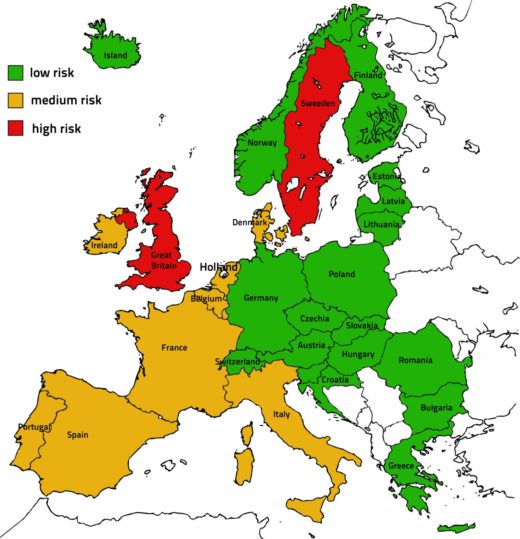As life is slowly returning to normal after the global lockdown caused by the COVID-19 pandemic, many European countries have already started relaxing the restrictions imposed on traveling, and together with this, they are also gradually reopening their borders. Since the Central European countries have been doing especially well during the pandemic, they are among the first countries to do so.
So where can you travel from the Czech Republic and what countries can let their citizens travel to Czechia?
The “Traffic Light System”
The so-called “Traffic Light System” was introduced by the Czech government on Monday, June 1. It is a map that shows how big the risk of getting infected with the COVID-19 is in different European countries:
- countries marked green are safe with a low risk of getting infected;
- traveling to countries marked orange is not recommended;
- countries marked red are considered unsafe with a high risk of getting infected.
How exactly does this work?
- As of June 15 traveling to countries marked green will be allowed with no restrictions being in place. It won’t be required to give the reason for entering the country which means that traveling for the purpose of a vacation will be allowed as well. Neither Czechs nor citizens of these countries will have to produce a negative test for COVID-19 or undergo the mandatory 14-days long quarantine upon their arrival to the Czech Republic from these countries.
- Starting on June 15, citizens of the Czech Republic will be allowed to enter the countries marked orange, however, the citizens of these countries will still have to produce a negative COVID-19 test upon their arrival into the Czech Republic or undergo the mandatory 14-days long quarantine.
- The countries marked red are considered high-risk and so it will be required to produce a negative COVID-19 test upon arrival from these countries or undergo the mandatory quarantine. This rule applies to everyone. Citizens of those countries won’t be allowed to enter the Czech Republic until decided otherwise.
APPLY FOR YOUR RESIDENCE PERMIT NOW
However, it is necessary to also keep in mind that other countries have their own set of rules and restrictions regarding traveling and these rules must be still followed. For example, traveling from the Czech Republic to Poland is allowed as Poland is considered safe by the Czech government, but at the same time, the Polish borders remain closed.
The same thing applies vice versa: for example, Sweden allows people to enter and leave the country with no restrictions but according to the Czech government it is a country with a high risk of getting infected and so when traveling from Sweden to the Czech Republic it is still necessary to produce a negative test for COVID-19 or undergo the mandatory 14-days long quarantine.
All the necessary information regarding the immigration process can be found on the Czech Ministry of the Interior’s webpage (UPDATE, July 20: The document was removed from the Ministry’s website).

Traveling to Slovakia and other neighboring countries
The border between the Czech Republic and Slovakia was reopened on Thursday, June 4. Citizens of these two countries, as well as EU citizens with a permanent or long term residence permit in the Czech Republic or Slovakia, are free to cross the border with no restrictions. This means that it is not required to produce any documents when entering these countries and nor is it necessary to produce a negative test for the COVID-19 upon return or to undergo the mandatory quarantine.
Traveling to Austria and Hungary is possible from June 5. As mentioned previously, traveling to Poland is allowed by the Czech government, yet it is not possible to cross the Polish border as it still remains closed. It should be, however, reopened on Saturday, June 13.
As for Germany, the border controls have been eased and Czech citizens can return from this country without submitting a negative test for COVID-19. Entering Germany is not allowed yet, though crossing the German border should be made possible for all EU citizens from June 15.
Changes as of June 8
Besides European countries gradually reopening their borders, there are more changes planned by the Czech government.
As of June 8:
- Events with up to 500 people will be allowed to take place;
- Theaters, cinemas, and concert halls no longer have to follow the rule regarding social distancing;
- The limits for the number of visitors to zoos, botanical gardens and arboretums will be increased to 250 people per hectare, so far there could be only up to 150 people present;
- Restrictions in restaurant gardens and the obligation to use face masks in outdoor swimming pool areas will be lifted;
- The provision of social services will be resumed on the basis of individual planning and contracts for the provision of social services.
If you don’t want to miss out on any important news, subscribe to our newsletter mapping the current coronavirus situation, and don’t forget to check this blog. To stay updated, you can also follow us on Facebook, where we live-stream on immigration topics on a regular basis, and on Instagram.
Oh, and one last important thing: Our offices in Brno, Prague, Olomouc, Pilsen, and Hradec Králové operate normally again. Let us know and get your residence permit as soon as possible to be safe in the future!
Sources of the information: Aktuálně.cz, the Czech Minister of Health’s Twitter account
Sources of the photos: Pexels.com, Twitter.com
The article was updated on June 10

finally opened, after a few months lockdown.